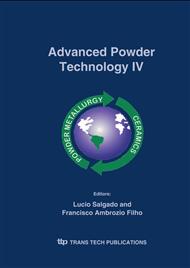p.125
p.129
p.134
p.141
p.146
p.152
p.158
p.164
p.173
Preparation of Nb-40Ti Powders by High-Energy Milling
Abstract:
Porous Ti-Nb alloys are promising candidates for biomedical applications. In the present study, alloy powders containing 60 wt-% Nb were prepared by high-energy milling of Nb, Ti, and/or TiH2 powders. The high-energy milling process was carried out in a planetary ball mill. The starting and as-milled materials were characterized by X-ray diffraction (XRD), and scanning electron microscopy (SEM). Elemental (Nb, and Ti) and TiH2 powder mixtures with composition Nb-40wt%Ti were mechanically alloyed for 2 to 30 h. The formation of a BCC Nb(Ti) solid solution by high-energy milling using elemental Ti powder to produce Nb-40Ti was observed after milling for 30 h. A HCP-Ti solid solution was formed after milling for 30 h due to the partial decomposition of titanium hydride powder mixture during high-energy milling.
Info:
Periodical:
Pages:
146-151
Citation:
Online since:
November 2005
Keywords:
Price:
Сopyright:
© 2005 Trans Tech Publications Ltd. All Rights Reserved
Share:
Citation:


